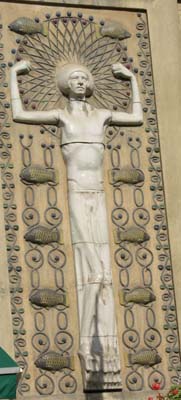
To 60 km in the west of
Krakow, the town of Oswiecim was the site of installation by the
Nazis of the concentration camp of Auschwitz-Birkenau. The museum
testifies to the plan of complete extermination of the Jewish people and
the atrocities made against other nationalities.
Robert MERLE, in his novel “Death is my job” gives
an analysis of psychology and behaviour of the person in charge for the
camp.
Prague, with Krakow, is one of the rare capitals of
Eastern Europe to have escaped the destruction from the WWII.
It is registered with the Inheritance World of Humanity. It was admired
and even adulated by the great romantic authors from Goethe to Apollinaire.
It is said by the authors of the guide books: “… the city of romantic and in
love people …”
But success has its reverse,
troops of tourists, shops, invading terraces of restaurants, advertising
soliciting. Where the romanticism is. One needs much imagination to
represent the city at the time of Mozart. Prague has become a tourist factory
since its independence.
The old city is built in a meander of Vltava. It is almost entirely dedicated to the pedestrians. To visit it, either by foot or by bicycle it was my choice, it is necessary to stop at each building, to enter into each courtyard, if possible, to see the various styles which are close to each other from Roman to Cubism. But it is difficult to be extracted from the merchandizing environment.

The Notre-Dame of Tyn church
XIVth century Gothic
building
with in front elegant Renaissance
frontage

Place
Staromestske
Frontages, baroque and neo-baroque
style of the XIXth century

Place Staromestske,
n°17
A. Storch Syb house, neo-gothic
frontage

Courtyard of Tyn,
Ungelt
set of buildings which
was used as customs

The municipal
house
inaugurated in 1912, Art nouveau style
called
“Secession”

Low-relief, skeletal
Woman
representative of the style
called “Secession”

Saint-Jacob
church
baroque style of the XVIIth
century
The Jewish city, Josefo, have nothing any more but some synagogues. In full real fever in the end of the 19th century, the old ghetto was destroyed to be replaced by “Art nouveau” buildings. The authors of the guide books speak about "the atmosphere of the old ghetto" which remains despite everything. There too, one needs much imagination.

The Old-New synagogue
roof notched out of
brick, Gothic style
The Hradcany district was one of the cities at the origin of the creation of Prague. It is built on a hill surrounded by gardens. The whole of the buildings constituting the castle and its dependences is at the top of the hill. The first building dates back to the XIth century. It was constantly increased and embellished by the various monarchs according to styles in force at their time, Gothic, Renaissance and finally Baroque. The municipal building is the palace of the president of the Czech Republic.

The castle and the Saint-Guy
cathedral

The Gold
lane
houses of the 16th
century
leant with the enclosure of the
castle
By visiting Prague and many other cities, it is necessary to keep in memory the social condition of the artists who took part in the realization of churches, palaces and monuments. Mozart was considered by his employer as a servant, even a slave.
| Du 2005/08/08 au 2005/09/12 | --Prague, capitale de la Tchéquie |
|
|
|
|
Prague,
avec Cracovie, est une l'une des rares capitales de l'Europe de l'Est à
avoir échappée aux destructions de la seconde guerre mondiale. Elle est
inscrite au patrimoine mondiale de l'humanité. Elle fut admirée et même adulée
par les grands romantiques de Goethe à Apollinaire. C'est disent les auteurs
des guides: " ... la ville des romantiques et des amoureux..." |
|
|
La vieille ville est construite dans un méandre de la Vltava. Elle est presque entièrement dédiée aux piétons. Pour la visiter, soit à pied soit à bicyclette ce fut mon choix, il faut s'arrêter à chaque immeuble, pénétrer dans chaque cours, si possible, pour voir les différents styles qui se côtoient du roman au cubisme. Mais qu'il est difficile de s'extraire du merchandising. |
|

L'église Notre-Dame du Tyn |
|

Place Staromestske |
|

Place Staromestske, n°17 |
|
|
La cour du Tyn, Ungelt |
|
|
La maison municipale |
|
|
Bas-relief, Femme squelettique |
|
|
Église Saint-Jacques |
|
|
La ville juive, Josefo, ne possède plus que quelques synagogues. En pleine fièvre immobilière de la fin du 19e siècle, l'ancien ghetto fut rasé pour être remplacé par des immeubles "Art nouveau". Les auteurs des guides parlent de "l'atmosphère de l'ancien ghetto" qui subsiste malgré tout. Là aussi, il faut beaucoup d'imagination. |
|
|
|
|
|
Le quartier Hradcany fut l'une des villes à l'origine de la création de Prague. Elle est bâtie sur une colline entourée de jardins. L'ensemble des bâtiments constituant le château et ses dépendances est au sommet de la colline. Le premier édifice date du XIe siècle. Il fut constamment agrandi et embelli par les différents monarques selon les styles en vigueur à leur époque, gothique, renaissance et enfin baroque. Le bâtiment municipal est le palais du président de la république. |
|
|
Le château et la cathédrale Saint-Guy |
|
|
La ruelle d'Or |
|
|
En visitant Prague et bien d'autres villes, il faut garder en mémoire la condition sociale des artistes qui ont participé à la réalisation des églises, des palais et des monuments. Mozart était considéré par son employeur comme un serviteur, voire un esclave. |
|
|
|
|
| Prague, the 2005/09/12 | |||